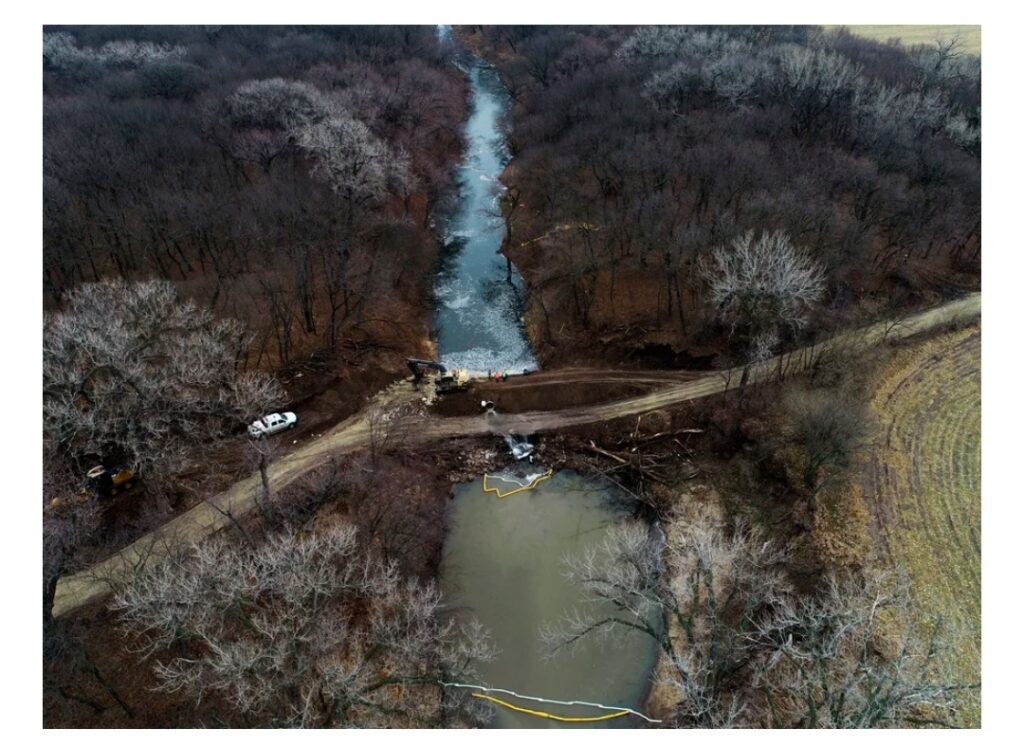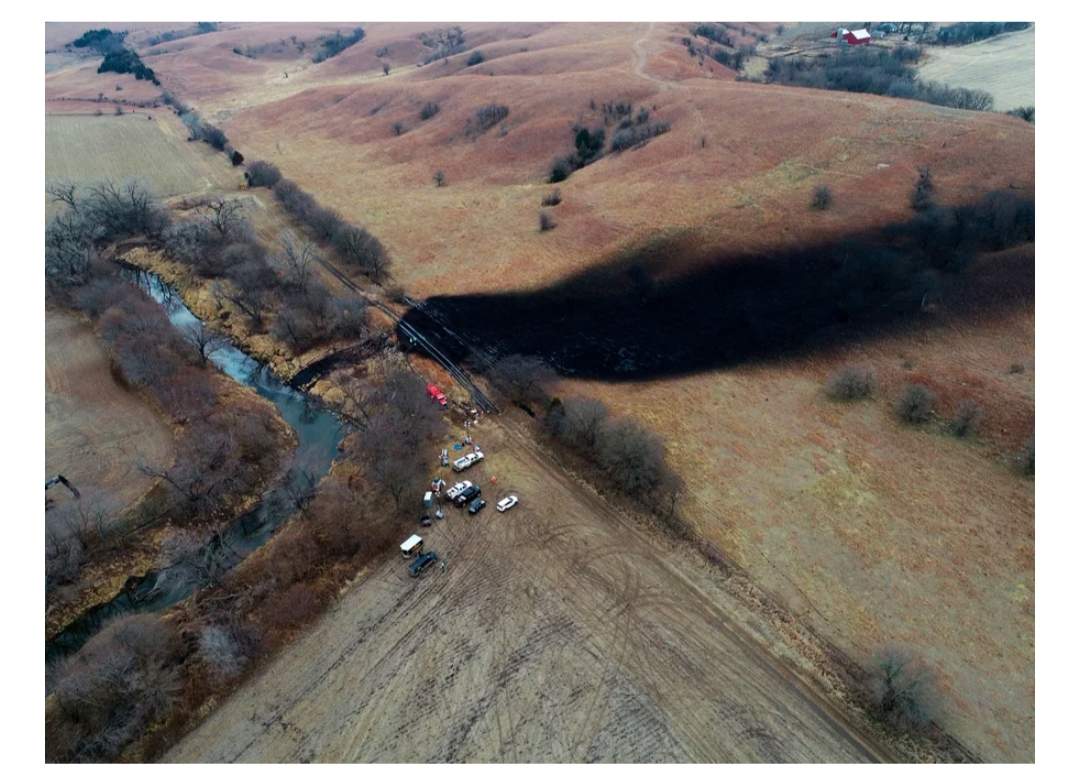
it’s been over a week since TC Energy announced its keystone pipeline leaked into Mill Creek in Washington County KAN. nearly 600,000 gallons of oil spilled into the waterway as well as the land surrounding it. The Keystone Pipeline leaked in Kansas. What makes this spill so bad?
Environmental advocates say this is just the beginning of a cleanup that will likely take years.
Operators were alerted to an issue with the pipeline on Dec. 7. As of Friday morning TC Energy says 4 125 barrels of oil from the creek have been recovered of the estimated 14,000 barrels [about 588,000 gallons] reportedly lost in the spill. The Keystone Pipeline leaked in Kansas. What makes this spill so bad
Aerial footage of the leak from Nebraska Public Media shows the leak has affected a nearby pasture and residents’ farmland.
Much initial detail like the cause of the spill is still not clear. What is known is the type of oil that was being transported through the pipeline tar sands oil also called diluted bitumen.
This thick toxic substance makes clean up so much more difficult said Jane Kleeb the founder of Bold Alliance and Anthony Swift director of the Canada project with the Natural Resources Defense Council both environmental advocacy groups. The Keystone Pipeline leaked in Kansas. What makes this spill so bad
When a tar sands disaster like this happens it is worse than a traditional oil spill. Because tar sands are much more difficult expensive and toxic to clean up we know that this is going to take years Kleeb told NPR. She said she’s been monitoring oil spills, particularly tar sands spills for 14 years.
She also notes that in her experience initial estimates of the amount of oil spilled can be wrong
Usually, when this happens that initial number ends up doubling she said
The full picture of the leak won’t be known until the recovery process is completed
in response to Kleeb’s comments, TC Energy told NPR in a statement our commitment to the community is that our response efforts will continue until we have fully remediated the site we have the people expertise training, and equipment to mount an effective response and clean-up and that’s what we’re doing
Diluted bitumen is like peanut butter”

TC Energy formerly known as Trans Canada says its keystone pipeline runs from Canada to Oklahoma [This keystone pipeline is not to be confused with the canceled Keystone XL pipeline project that was a major flashpoint in the U.S. for years.]
Even though TC Energy maintains that it has the right training and equipment to effectively respond to the Mil Creek spill the effort will be a daunting one swiftly said.
Bitumen doesn’t flow through a pipeline efficiently so it is mixed with diluents to be readied for pipeline transportation as diluted bitumen or dilbit the American Petroleum Institute says
It’s a very thick substance that’s almost peanut butter consistency said Swift with NRDC.
Most containment efforts don’t work for bitumen, he says in situations of other oil spills affecting waterways one of the first steps is to set up booms to prevent the oil from spreading farther in the water.
Diluted bitumen doesn’t float the way conventional oil does And most means of spill remediation in water bodies do rely on most of the oil staying on top of the water body Swift said.
Bitumen eventually sinks to the bottom of rivers and wetlands making containment and the environmental consequences far more difficult and expensive.
On land, this material causes major problems thanks to the bitumen’s incredibly strong adhesive properties, swiftly said.
Once this thick tar sand is on something you have to just extract everything that this stuff has touched he said the bitumen can migrate and it tends to seep into soils the longer it’s left the more of a problem it can become.
The Keystone Pipeline leaked in Kansas. What makes this spill so bad?

Both Kleeb and Swift said this latest keystone leak reminded them of the 2010 Kalamazoo River oil spill. in July 2010 over a million gallons of tar-sands crude oil was released into Talmadge Creek a small tributary to the Kalamazoo River near Marshall Mich according to the Kalamazoo River watershed council. this environmental disaster was the result of a ruptured pipe from Enbridge Energy Partners LLC. The spill resulted in a 30-mile stretch of the Kalamazoo River getting contaminated.
From 2010 to 2014 over 1.2 million gallons of oil were recovered from the river according to the Environmental Protection Agency. Estimates in the years since the cleanup suggest it cost over $1 billion.
Kansas and people on the ground are going to have to prepare for the long haul Kleeb said.
”I haven’t seen tar sands spill of this scope in a creek. We don’t know what that is going to look like and how it is impacting the biodiversity in that creek not to mention the pasture land Kleeb said The Keystone Pipeline leaked in Kansas. What makes this spill so bad?
in the past when we’ve seen the spill happen it impacted the land for years They not only have to excavate all of the polluted soil there is a lot of work to be done to make sure that this isn’t impacting the root system she said And now all of that precious topsoil which is critical to agriculture is destroyed and will be destroyed forever.”
This is not TC Energy’s first, second, or third spill
Keystone has been the subject of 22 reported leaks since 2010 according to a Government Accountability Office report last year. with the Mill Creek case, it is now up to at least 23.
”Keystone’s accident history has been similar to other crude oil pipelines since 2010 but the severity of spill has worsened in recent years, GAO said. ”Similar to crude oil pipelines nationwide most of Keystone’s 22 accidents from 2010 through 2020 released fewer than 50 barrels of oil and were contained on the operator-controlled property such as a pump station.” The Keystone Pipeline leaked in Kansas. What makes this spill so bad?
Before construction, TC Energy got a special permit from the Pipeline and Hazardous Materials Safety Administration [PHMSA] to operate certain portions of the pipeline at a higher pressure level than is ordinarily allowed under agency regulation for oil transport.
Though the reason for the spill is still unknown, both Swift and Kleeb voiced concerns over this permit and questioned if the higher stress level was potentially a major factor in the latest spill.
That is unusual that is not the norm she said of the number of spills from this one pipeline they should have never given a company with this many spill a special permit to pump at higher pressure.” The Keystone Pipeline leaked in Kansas. What makes this spill so bad
PHMSA told NPR that ”regulations have extensive requirements for pipeline accident reporting.” Federal regulation requires accident reports of incidents that have a release of 5 gallons or more of hazardous liquid or maintenance-related releases,” an agency spokesman said.
Not including the Mill Creek leak the two largest spills in Keystone’s history occurred in 2017 and 2019. As of Dec. 7 government data shows that this spill is the biggest in the pipeline’s history, the Associated Press reported.
In response to the Mill Creek case [as it has with each of Keystone’s largest previous spills] PHMSA issued corrective action orders,” the agency’s most stringent enforcement tool a spokesman told NPR. The Keystone Pipeline leaked in Kansas. What makes this spill so bad?
